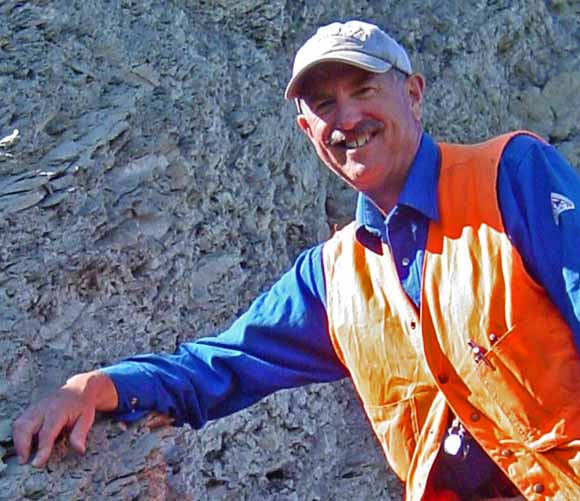
Location: Stanford University
see Map showing Mitchell and GeoCorner Room 320
This will be the 398th meeting since 1954

The Brooks Range orogen consists from north to south, of a frontal domain of detachment folds and passive-roof duplex in the Colville foreland basin, an axial zone with imbricate thrusts in the northern Brooks Range, and a hinterland composed of ductilely deformed metamorphic rocks in the southern Brooks Range. Although structures are everywhere mostly coaxial and north-vergent, deformation was diachronous: Jurassic and Early Cretaceous in the axial zone and hinterland, and Tertiary in the frontal zone. As a result, models calling for deformation in the Jurassic and Cretaceous do not explain the young age of frontal structures, whereas those calling for deformation in the Tertiary do not explain Mesozoic deformation in the Brooks Range.
This paradox can be explained by a deformational history wherein the Brooks Range was formed by superposed contractional events having distinctive ages, structural styles and tectonic origins. The first event was a north-directed arc-continent collision with the Koyukuk arc which was active from ~145-112 Ma. This deformation produced a thin-skinned deformational wedge composed of allochthons of a collapsed south-facing passive margin sequence and overlying ophiolite allochthons at high structural levels. Blueschist facies metamorphism occurred in the hinterland. This event ended in crustal-scale extensional collapse of the hinterland during the mid-Cretaceous (~103-96 Ma). The extension thinned previously thickened crust and produced regional unroofing that reset Ar-Ar ages and shed voluminous clastic sediments into foreland and hinterland basins. The second contractional event at 60 to 45 Ma was caused by retroarc thrusting emanating from a south-facing subduction zone in southern Alaska. This thrusting involved a deep level of detachment and produced a thrust belt with relatively high structural relief and low amounts of shortening that terminated in the frontal domain of detachment folds in the Colville basin. A third episode of contraction in the Oligocene and Miocene produced a structural salient in the northeastern Brooks Range marked by basement-involved deformation onshore and a thin-skinned frontal zone that extends offshore across the continental margin and slope.

Thomas Moore is a structural geologist with the Energy Resources and Mineral Resources programs of the U.S. Geological Survey in Menlo Park, California. Born in Napa California, he earned a BA at U.C. Santa Barbara, a MS at San Diego State University and, in 1983, a Ph.D at Stanford University. Following graduation, Tom worked with ARCO in Anchorage prior to joining the USGS Branch of Alaskan Geology in 1985. His work in Alaska began as a USGS field assistant in 1979 and culminated in a comprehensive summary of the geology of northern Alaska for the DNAG series 1994. Since then, he has worked on USGS petroleum assessment projects on the North Slope and the Arctic and structural studies of the Red Dog Pb-Zn mineral district in the western Brooks Range with the tectonics and structural evolution of the Brooks Range being his main research focus.
Reservations: The preferred way to make reservations is simply to email John Spritzer at jspritzer@usgs.gov by June 6, tell him you will attend, commit to pay, and bring your payment to the meeting. John always emails a confirmation; if you don’t get one, assume email crashed yet again and email him a second time. A check made to “PGS” is preferred, payable at the meeting.
If you want to pay in advance:
Everyone (including Stanford folks now) Please make dinner reservations by June 6. Contact John Spritzer, at U.S. Geological Survey, 345 Middlefield Road, MS-973 Menlo Park, CA 94025, Tel.: (650) 329-4833. Send check made out to “PGS” to John.
Dinner is $30.00. Includes wine (5:30 to 6:15 PM.) and dinner (6:15-7:30 PM.).
For students from all universities and colleges, the dinner, including the social 3/4-hour, is $5.00 and is partially subsidized thanks to the School of Earth Sciences, Stanford University (Note, no-show reservations owe the full price).
Doris, whose wonderful crew prepares our meals, asked that we let you know that people who are late RSVPing and people who show up without a reservation will be welcome but that they will be eating on paper plates with plastic utensils (food supply permitting).
Dues for Academic Year 2007-2008 ($10.00) should be sent to John Spritzer, U.S. Geological Survey, 345 Middlefield Road, MS-973 _Menlo Park, CA 94025. John’s phone: (650) 329-4833.
Officers: Tom Moore, President; Keith Howard, Vice President; Mike Diggles, Secretary; John Spritzer, Treasurer; Elizabeth Miller, PGS Stanford University Coordinator

Date created: June 12, 2008
Last modified: June 12, 2008
Created by: Mike Diggles, Webmaster-Secretary, PGS.